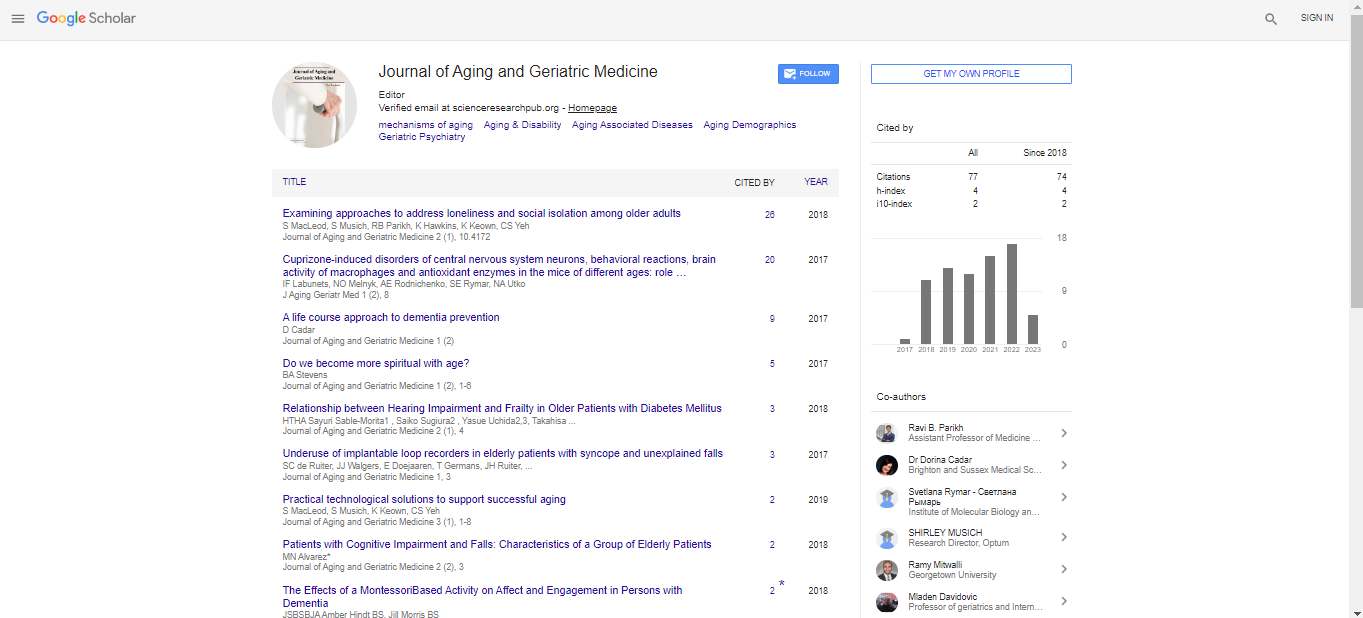Commentary, J Aging Geriatr Med Vol: 6 Issue: 3
Individual Bio gerontologists navigate Their Contested Field
Roselle Ponsaran*
Department of Bioethics, Case Western Reserve University, Cleveland, USA
*Corresponding author: Roselle Ponsaran, Department of Bioethics, Case Western Reserve University, Cleveland, USA
E-mail: roselle.ponsaran@case.edu
Received date: 01 March, 2022, Manuscript No. AGM-22-60771;
Editor assigned date: 03 March, 2022, PreQC No. AGM-22-60771 (PQ);
Reviewed date: 17 March, 2022, QC No AGM-22-60771;
Revised date: 22 March, 2022, Manuscript No. AGM-22-60771 (R);
Published date: 29 March, 2022, DOI: 10.4172/ ISSN: 2576-3946.1000132.
Citation: Ponsaran R (2022) Individual Bio gerontologists navigate Their Contested Field. J Aging Geriatr Med 6:3.
Keywords: Medical Exploration
Description
This paper infuses a new perspective into education onanti-aging wisdom the gests of individual scientists as they've entered and navigated this controversial field. We draw on in- depth interviews with 43 prominent memoir gerontologists to negotiate three objects. First, we punctuate crucial factors that draw scientists into bio gerontology – especially the unique and complex mystifications posed by growing. Second, we examine how bio gerontologists define themselves and their exploration in relation to “anti-aging” wisdom – particularly how scientists part themselves from the tarnished history of the field and employ important language to distinguish licit from illegitimate education, and wisdom from assiduity. Eventually, we explore how individual scientists manage any social, religious, and ethical expostulations to conducting “anti-aging” exploration — and the force of responses they use to contemporaneously strike expostulations and support the legality of their wisdom. The analyses reveal how important is eventually at stake for these individual scientists on the frontal line.
India, with a population of1.22 billion, has a generally husbandrygrounded frugality. Its 90 million senior population heavily depend on their children for fiscal support and caregiving. Research on growing in India moment is concentrated on the medical, natural, behavioral, and social lores. Aging as an independent subject is only tutored at a many institutions. Several public and state agencies and numerous nongovernmental associations offer casing, day care, and health care services. The 1999 National Policy on Aged Persons is being revised, 2 National Institutes on Aging have been designated, and a airman health program targeting seniors has been enforced. India’s topmost concern is how to give acceptable health care and income security for its huge senior population, especially the uninstructed pastoral poor.
India derives its name from the Indus River that flows from the Himalayan Mountains. A country of myriad mores that constitute a concinnity in diversity, its ancient history reaches back to 2000B.C. As the world’s largest republic, India grounded its administrative system of government on that of the United Kingdom, from which gained its independence in 1947. As a civil union, it includes 29 countries and 7 Union Homes (UTs).
Developments in Education, and Training
India’s constitution officially recognizes 23 of the numerous languages spoken by its citizens. Hindi and English are the primary languages used in academia and in conducting business. Eighty percent are Hindus, 13 are Muslims, and 3 are Christians. Sikhs, Jains, and Buddhists comprise the rest. Although India’s artificial sector and specialized prowess have grown fleetly, husbandry continues to be the dependence of the Indian frugality.
Average per capita income is Indian rupees or aboutUS$ annually; nearly one third of its population lives below the poverty line, on lower than$1.50 a day. The Gross Domestic Product in 2011 was$1.85 trillion. The overall knowledge rate is 74 82 for men and 66 for women. This brief background sets the stage for examining issues concerning India’s growing senior population.
Two public data sets, the Registrar’s Census of India and reports from the National Sample Survey Organization (NSSO), give utmost of the information about India’s elderly citizens. Statistics about the senior population are drawn from the most recent NSSO check of 2005 and published in 2006; the coming review will be conducted in 2015. The 2011 public tale systems that the current total Indian population of1.22 billion — second only to China — will exceed1.4 billion by 2030. The senior population of 90 million may reach 130 million by 2030. India’s fertility rate of2.5 live births may drop further, adding the current reliance rate 125 aged per of the general population periods 14 – 59. Average life expectation at birth is69.8 times 68 times for men and 72 times for women. Life expectation at age 60 is 18 times for women and 16 for men. About3.5 of the total population is further than 80 times of age, with women in the maturity.
In terms of education and health status, 74 of pastoral and 40 of civic elders demanded formal training in their youngish times, with counteraccusations for penetrating and addressing their health care requirements. Reported affections are kindly advanced in pastoral areas where health services are frequently in short force. Still, civic aged women are more likely to be immobile, with counteraccusations for lesser domestic care responsibility. The absence of universal social security and health programs contribute to the reliance of India’s senior population.
Originally, medical exploration on morbidity in the senior population was sanitarium- grounded, beginning with the work of Pathak at Bombay Hospitals. Followed by the sustained work of Venkoba Rao Rajaji Hospital in Madurai, exploration concentrated on physical and cerebral morbidity, especially internal health, depression, and self-murder in the aged. During this pioneering period, Rao also directed the first Task Force on Aging of the Indian Council of Medical Research. In 1988, a separate in- case ward for elders was created by Natarajan at the Government General Hospital in Madras. An inpatient clinic for the progressed was established in 1996 by Vinod Kumar at the All India Institute of Medical Lores, New Delhi, to conduct a series of morbidity studies.
 Spanish
Spanish  Chinese
Chinese  Russian
Russian  German
German  French
French  Japanese
Japanese  Portuguese
Portuguese  Hindi
Hindi 